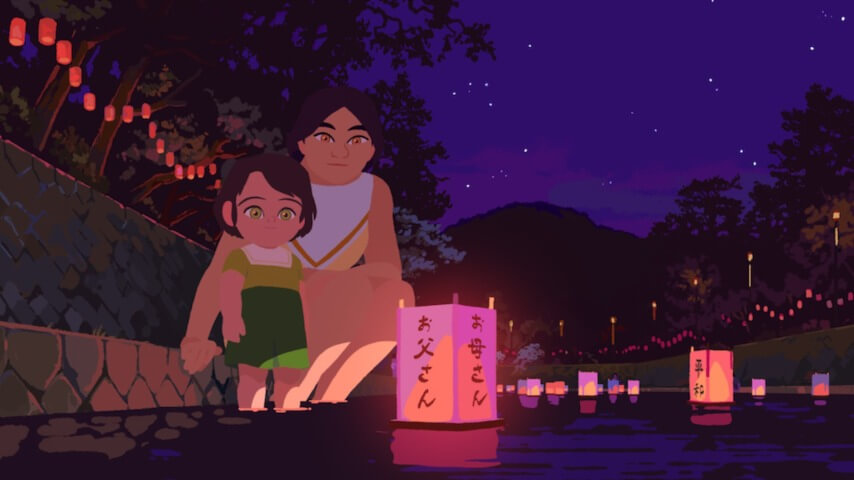It’s not as pretentious as it sounds, though it’s often as whimsical as the more famous Amélie. Its script ties these lofty self-centered ideas to sillier childhood ones: Amélie (and God, in her imagination) is really just a tube. Food goes in. Waste comes out. There’s no intention, just constant processing. The same kind of limits are imposed upon Amélie’s conception of the world during a riveting scene in which she discusses death with her affectionate nanny, Nishio-san (Victoria Grosbois). Nishio-san describes her memories of World War II while cooking, sifting through rice as she recalls being buried alive by debris from the bombs. Each traumatic image is filtered through food prep, visualizing the struggle of a toddler to comprehend something so large and terrible.
It’s just one way in which Little Amélie Or The Character Of Rain evokes the experience of its central child. From the pure abstraction of its opening springs a digital impressionism, where vivid blocks of colors and simple lines turn everyday objects into magical curiosities, painting Amélie’s life across fields and beaches and her family’s home. The cluttered, vibrant environments pop with the same focus as those moving through them; the massive eyes of the characters are there not to look at each other, but take in everything around them. There’s a reason Amélie’s first words aren’t “mama” or “daddy” but “vacuum cleaner.” She’s more interested in the world than her family, her mother or father or siblings. It’s endearingly specific; scenes sprawl out and blend together like the liquid memories of childhood, with her relatives only really standing out in the few moments where their strong emotions arm-wrestle those of Amélie. The exceptions are the people who treat her like the god her baby-brain believes her to be, notably her doting grandmother (Cathy Cerdà) and nurturing Nishio-san.
Despite using her relationship with her Japanese caretaker to explore the lingering darkness of war, and the long tail of suspicion and resentment it casts behind it, Little Amélie strains against the limits of a story about a little white girl’s relationship with her non-white nanny. But the other life-altering memories that persist from toddlerhood balance the story accordingly; being torn between Japan and Belgium pales to being torn between life and death (even if it all adds up into a vaguely Buddhist worldview). Amélie’s more impetuous personal struggles, her hopeless tantrums and foolish choices, give the film some thematic and age-specific distance from those of Studio Ghibli. Going head to head with that animation house around stories about post-war Japan is a losing proposition, but Little Amélie submerges itself in fantastical ecstasy and melancholy with a magic all its own.
A brief 71 minutes, Little Amélie Or The Character Of Rain passes by in a blink, just like the few months of life it covers for its central tyke. And it doesn’t need more than that to make an impact. Its warm-hued, confident style, as bold and lovely as a headstrong child’s drawing, empowers Nothomb’s recollections of an early life spent already caught by the tides. Countless other films cover youth’s first brushes with death, with self-definition, with the limits of our powers. Few tackle them all at once, and from such a recognizable developmental headspace. And Nothomb’s book never moves past that age, because “After that, nothing more happened.” Nothing that mattered that much in the grand scheme of things, anyway.
Director: Maïlys Vallade, Liane-Cho Han
Writer: Liane-Cho Han, Aude Py, Maïlys Vallade, Eddine Noël
Starring: Loïse Charpentier, Victoria Grosbois, Yumi Fujimori, Cathy Cerdà, Marc Arnaud, Laetitia Coryn
Release Date: October 31, 2025

